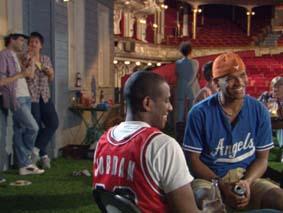Say Hello to Peace and Tranquility
dal 21/3/2002 al 27/4/2002
Segnalato da
Andreas Gedin
Gary Hill
Teresa Hubbard
Alexander Birchler
Dagmar Keller
Martin Wittwer
Franciska Lambrechts
Mike Marshall
Hans D. Christ
Iris Dressler
Jan Schuijren
21/3/2002
Say Hello to Peace and Tranquility
Netherlands Media Art Institute, Amsterdam
The exhibition introduces video installations that are involved with the structure of language and/or reconstructed spaces. They examine the mechanisms of physical and especially psychological inclusion and exclusion patterns that are anchored in language as well as in architecture.

Andreas Gedin (S)
Gary Hill (USA)
Teresa Hubbard / Alexander Birchler (USA)
Dagmar Keller / Martin Wittwer (D)
Franciska Lambrechts (B)
Mike Marshall (GB)
The Netherlands Media Art Institute, Montevideo/Time Based Arts presents from March 23 -
April 27 the exhibition Say Hello to Peace and Tranquility curated by Hans D. Christ, Iris
Dressler (Dortmund) and Jan Schuijren (Amsterdam).
The exhibition "Say Hello to Peace and Tranquility" introduces video installations that are involved with
the structure of language and/or reconstructed spaces. They examine the mechanisms of physical and
especially psychological inclusion and exclusion patterns that are anchored in language as well as in
architecture. The main focus of the exhibition is the significance of space and language in our private,
intimate life as an assumed guarantee of tranquility, order and harmony.
Language and speech are like architecture the basic elements of our Western conception of the world.
They assign established positions to the interior and exterior, subject and object, here and there - yet
they are nothing but makeshift constructions or vehicles that threaten to collapse easily. Furthermore,
language and architecture are reflections of the relationships between power and weakness.
Thanks to the advances in digital imaging, which allow a user to navigate through entire urban
environments using hyper-real architectural simulations, we more and more regard the world as virtual
building blocks. "Real" architecture, like theme parks and shopping malls, is subscribing to that
artificial, model-like design. In contrast, "real life" seems to be occurring in front of the same backdrop
of TV family dramas, whose facades and interiors - set in the so called "gated communities", those
high-security tracts of private bliss - appear to be perfect. No one would be surprised if one of these
days spotlights will fall from the sky
The video installation of the artist duo
of Dagmar Keller and Martin
Wittwer explores the clichés of the
sophisticated romance in terrace
town homes. In Say Hello to Peace
and Tranquility the camera moves,
devoid of plot, through the backdrop
of suburbs that are completely
deserted. Images, which seem to
come from the conventional world of
model train sets are mixed with
scenes from real terrace house
homes. However, it is difficult to
differentiate between the model world
and reality, and the question arises
which of these worlds is serving as
the dull role model.
In the video installation Full House
by Teresa Hubbard and
Alexander Birchler "home"
becomes the scene of a
stereotypical and at the same time
fractured narration about desire, the
delay of desire and frustration,
turning into desire again. The
person's own four walls as an
imaginary palladium of security for
the individual and at the same time
for social interaction turns up
continuously, in the oppressive
experience of isolation.
Mike Marshall's video work,
Somewhere, Someone is doing
this draws the viewer into an
equivocal psychological and
emotional situation, by displaying
the hyper-aesthetic, almost hypnotic
spectacle of a sunset.
The video installations by Gary Hill,
Andreas Gedin and Franciska
Lambrechts grapple with the
structure of language. For example,
Franciska Lambrechts explores the
different social and psychological
relationship patterns within the
"family" system using complexly
interwoven dialogues. Security and
isolation, desire and frustration,
inclusion and exclusion, violence and
resistance do not take place within
the safe and familiar four walls, but
instead appear to take place within
language itself.
While woman and man, mother and
daughter as well as mother and son
in Franciska Lambrechts' videos
wrestle with their differences,
Andreas Gedin shows the almost
restless dissolution of difference in
his video work Gemini: Two identical
people tell a story together, with one
person always completing the other
one's words. The language appears
to wander almost seamlessly from
one person to the other and back
again. The speakers do not use the
language here, but instead the
language appears to seize the
speakers.
Gary Hill even makes the
performers in his video Why Do
Things Get In A Muddle? (Come
On Petunia) speak backwards.
However, since the video itself is
running backwards, the structure of
the language is, in a limited way,
restored. By talking back and forth,
the father and daughter struggle with
the structure of order and disorder.
Image: Teresa Hubbard / Alexander Birchler (USA) Full House, 2001
With thanks to the Goethe Institute, Amsterdam
http://www.goethe.de/be/ams/nlindex.htm
Opening march 22 5pm-7pm
Opening hours: Mon - Fri 9.00 - 17.00 h.
Gallery: Tu - Sat 13.00 - 18.00 h.
Reference Room: Mon - Fri 13.00 - 17.00 h
For more information please contact Marieke Istha (communication) istha@montevideo.nl
Netherlands Media Art Institute
Montevideo/Time Based Arts
Keizersgracht 264
NL 1016 EV Amsterdam
T +31 20 623 7101
F +31 20 624 4423



